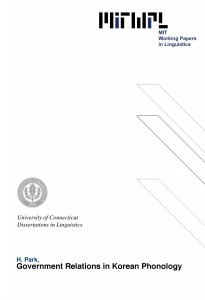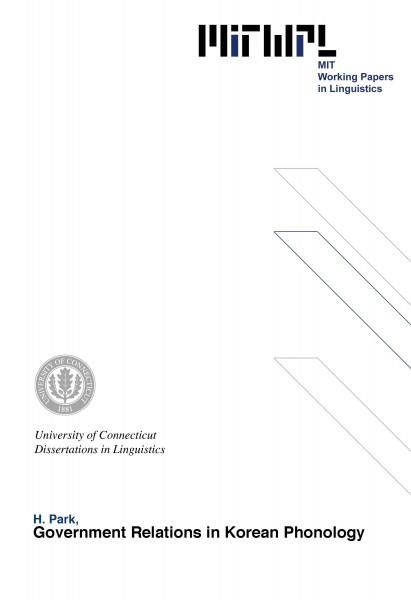Government Relations in Korean Phonology
H. Park, 1996
ABSTRACT
One goal of linguistic theory is to uncover universal principles which constrain the class of attainable grammars. Recent work in phonology has pursued this goal in terms of the principles and parameters framework. One line of this work is found in Government Phonology (Kaye, Lowenstamm & Vergnaud, 1985 and 1990), where it is proposed that syllables are bound together in terms of government. This thesis explores phonological phenomena in Korean such as tensing, neutralization, voicing, umlaut and palatalization within Government phonology, to test its proposals and extend its coverage to a new range of data.
In the testing of hypotheses within this theory, the analysis of Korean exposes problems pertaining to the Projection Principle of Government Theory, which requires that government is defined in lexical representations and remains constant throughout a derivation. However, in Korean, government appears to be established during the derivation. It does not hold in lexical representation. I raise the question of whether Government Theory requires the Projection Principle and explore replacing it with a derivational account of government. Reconsidering the analysis of Tigrinya which motivates the Projection Principle, I argue that it does no work there. I then investigate how a derivational account of government handles the Korean phenomena.
The second issue of this thesis is how we can account for phonological derivations in a principled way within Government Theory. In Harris' (1990) theory of segmental complexity, where the ultimate constituents of segments are unary elements, alternation is given by two operations: composition and decomposition. However, Harris does not explain why one applies rather than the other when either can achieve a government relation, nor can he predict how many internal elements, or which ones, are affected by any operation. To address this issue, I extend lexical representations in the Government framework along the lines of the Markedness Theory approach (Michaels 1989) and use economy (Chomsky 1991, 1993 and Chomsky & Lasnik 1991) to choose between derivations. Markedness Theory accounts for why operations affect certain elements. Economy explains why a specific government relation is established when more than one such relation is possible.
Chapter 1. Introduction 1
Chapter 2. Some Linguistic Phenomena in Korean and Earlier Treatments
2.1. Obscurant Phenomena Between Verb Stem and Ending in Korean 6
2.1.1. Korean Consonant Inventory 6
2.1.2. Tensing, Neutralization, and Voicing Phenomena in Korean 9
2.1.3. Consonant Cluster Simplification 16
2.2. Umlaut and Palatalization 24
2.2.1. Korean Vowel Inventory 24
2.2.2. Umlaut and Palatalization in Rule-based Framework 25
2.2.3. The Analyses of Umlaut and Palatalization in Feature Geometry 28
2.2.3.1. Autosegmental. Phonology 28
2.2.3.2. Overview of Feature Geometry 31
2.2.3.3. Hume's (1990) Analysis and Its problem 35
Chapter: 3. An Analysis of Korean Linguistic Phenomena in terms of Government
3.1. A Theory of Government in Phonology 43
3.1.1. Theoretical Background: Prosodic Government 43
3.1.2 . Phonological Government 46
3.1.2.1. Charm Theory 48
3.1.2.2. Proper Government and Empty Category Principle 50
3.1.2.3. Coda Licensing Principle 52
3.1.2.4. Projection Principle 55
3.1.2.5. Interconstituent Government between Two Obstruents 58
3.2. An Analysis of Korean Linguistic Phenomena in terms of Government 59
3.2.1. An Analysis of Obscurant phenomena 59
3.2.2. Segmental Complexity and Phonological Government 64
3.2.2.1. Internal Representation of Segments in Government Theory 64
3.2.2.1.1. Internal Representation of Vowels 64
3.2.2.1.2. Internal Representation of Consonants 69
3.2.2.2. Segmental Complexity 70
3.2.3. Analyses of Korean Linguistic Phenomena 74
3.2.3.1. The Representation of Segments in Korean 74
3.2.3.2. Analyses of Tensing and Neutralization Phenomena 75
3.2.3.3. Analysis of the Consonant Cluster Simplification Phenomenon 81
3.2.3.3.1. Government Licensing Theory 81
3.2.3.3.2. Analysis of Korean Consonant Cluster Simplification 81
3.2.3.4. Analysis of the Umlaut and Palatalization 91
Chapter 4. Proposed Analysis in Extended Government Phonology 102
4.1. The Theoretical Background for the Proposed Analysis 103
4.1.1. Syllable Structure Approach 103
4.1.2. Minimalist Approach 109
4.2. Proposed Analyses 112
4.2.1. An Analysis of Tensing and the Neutralization 112
4.2.2. An Analysis of Intersonorant Voicing 120
4.2.3. An Analysis of Consonant Cluster Simplification 123
4.2.3.1. Prince & Smolensky's Nuclear Harmony Constraint 126
4.2.3.2. Hong's Sonority Analysis 129
4.2.3.3. An Analysis of Consonant Cluster Simplification 130
4.2.4. Residual Cases 147
4.2.5. Umlaut and Palatalization 154
Chapter 5. Conclusion and Implication 177
Bibliography

